Palo verde paradise at Arizona State University Polytechnic campus
For all you snowbound readers up north or eager-beaver gardeners down south, you’ll find lots of floral sunshine in this post, which I’ve been holding onto since last spring. During my Phoenix visit last April, my friend Noelle, aka AZ Plant Lady, took me to some water-saving gardens around town, including the beautiful grounds at Arizona State University’s Polytechnic Campus in Mesa.
The campus, formerly an Air Force base, was originally a bleak expanse of hot paving and river rock. Austin’s own Christine Ten Eyck ripped up the paving (repurposing some of it as garden benches and paving-stone paths) to create a garden of flowering native plants that provide shade and feed pollinators, welcoming courtyards, vine-draped arbors, and creative water harvesting.
In 2012, the American Society of Landscape Architects (ASLA) recognized the garden with an Honor Award. As Ten Eyck’s project narrative explains,
Our team reviewed the campus master plan which had a decidedly Ivy League approach to the campus design and developed a new master plan strategy for the project. We reinvented what a campus could be in the unique region of the Sonoran desert which only receives 7″ of rainfall a year.
7 inches of rain — that is not very much. Yet plants like aloes and palo blanco trees grow well here with minor supplemental watering.
The river rocks that once made inhospitable paving now fill courtyard-defining gabion walls, which also shade plant roots from summer’s heat.
Cooling shade, enclosure, and places to sit
Tall gabion walls echo interior walls, sheltering an outdoor dining or studying area, with eye-catching green seating.
Some of the buildings are enclosed by a metal scrim, presumably for shade and to support high-climbing vines, which shelter the buildings from the desert sun. Noelle identified the vine as grape ivy (Cissus trifoliata).
This large courtyard is paved with stabilized decomposed granite, which allows rainwater to percolate through. Clean-lined concrete benches invite relaxation.
A concrete cistern filled with river rock collects rainwater, when it comes, and spills it into a dry creek. I confess I’m not exactly sure how this sort of cistern works, since it’s raised above ground level. How does rainwater fill it? Maybe it’s pumped up from underground pipes?
Industrial-style Corten arbors line walkways for shade. Interesting shadows are a bonus.
Lady Banks roses climb the arbors, softening the steel with cascades of ruffled flowers.
But the showiest flowers were blooming in the bare branches of palo verde trees, which glowed like secondary suns all over campus, and indeed all across Phoenix during my early April visit.
I’m familiar with the charms of forsythia from my Carolina childhood. But this — forsythia times 100!
I could not get enough of it, those golden trees glowing against a cloudless, blue desert sky.
Yellow is the color of spring in Arizona, for along with the palo verdes I saw octopus agave (A. vilmoriniana) in towering bloom…
…and aloe vera (Aloe barbadensis), with its subtler spires.
More palo verdes shade a water-collecting basin and a long concrete bench.
Another high steel arbor shades an L-shaped banco, while more of those green dining sets invite socializing or studying.
This sunny courtyard near the parking lot was ablaze with California poppies and a palo verde, with a Cereus peruvianus (thanks for the tentative ID, Janis), barrel cactus, and purple prickly pear adding year-round structure.
A Spanish-style tiered fountain drips musically along a broad walkway. Ten Eyck, who is exceedingly water conscious with her designs, has told me she believes in using water sparingly but symbolically in dry climates to evoke an abundance that isn’t there, and to visually cool gardens.
It’s a shame that the City of Austin doesn’t agree and has banned the running of municipal and residential fountains for the past several years as a water-conservation measure. A small fountain is almost a spiritual gesture in a hot climate, and birds, insects, and other wildlife depend on artificial water sources when creeks run dry. But that’s a rant for another day.
Even desert plants need water to get established, and a simple trench effectively delivers runoff water to this young mesquite.
The entire garden is an inspiring example of how to make a hospitable garden with not a lot of water in a harsh climate. My thanks to Noelle for showing it to me!
If you’re interested in sustainable gardening in the desert, you might like to visit Underwood Family Sonoran Landscape Laboratory at the University of Arizona in Tucson. I didn’t visit that one this time but hope to one day. Also see my post about Scottsdale’s inspiring Xeriscape Garden. Both are, like the Polytechnic campus garden, designed by Ten Eyck Landscape Architects.
All material © 2006-2015 by Pam Penick for Digging. Unauthorized reproduction prohibited.


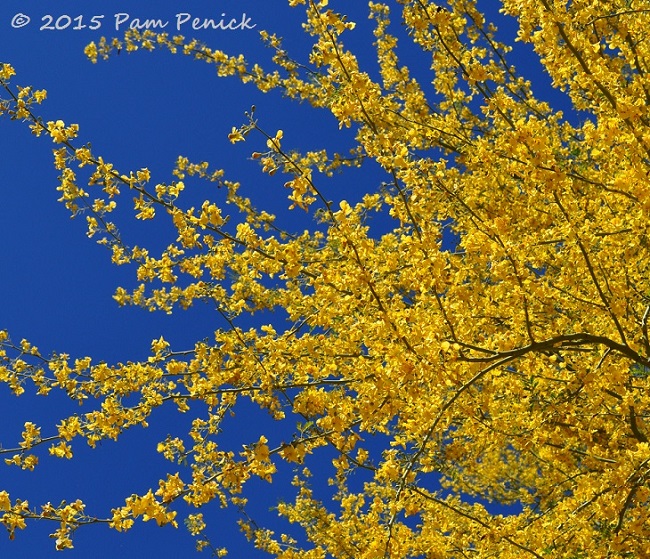
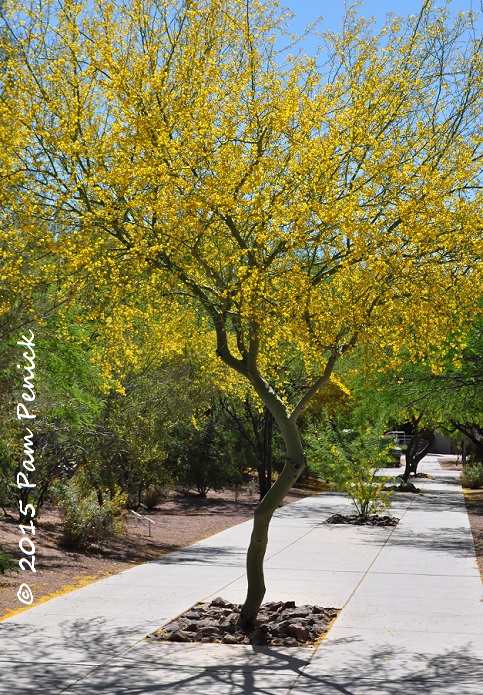
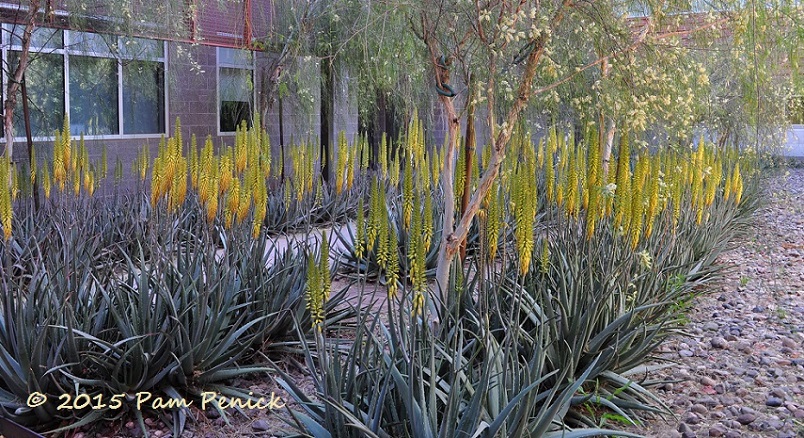
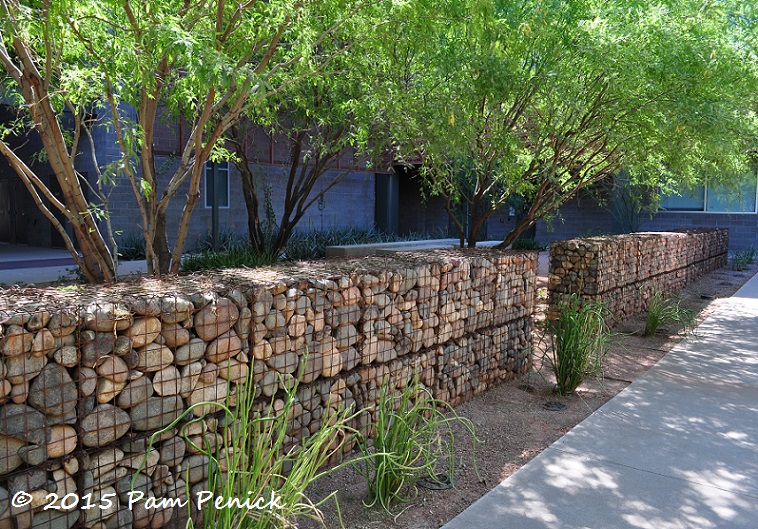
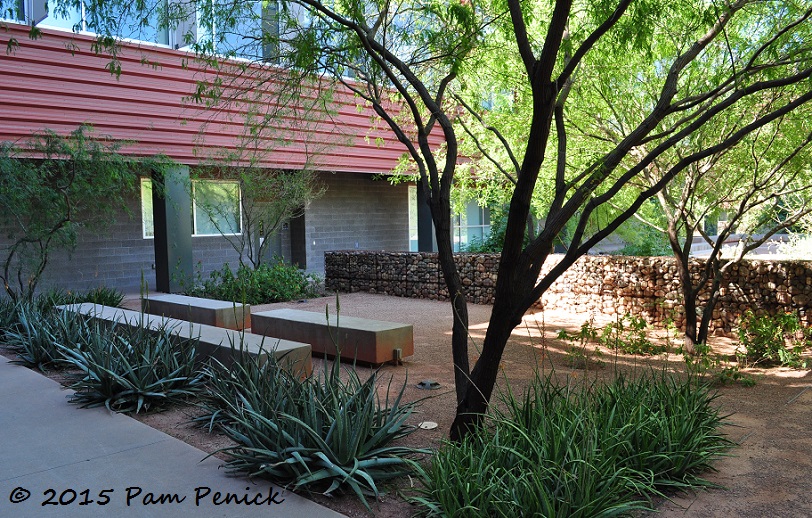
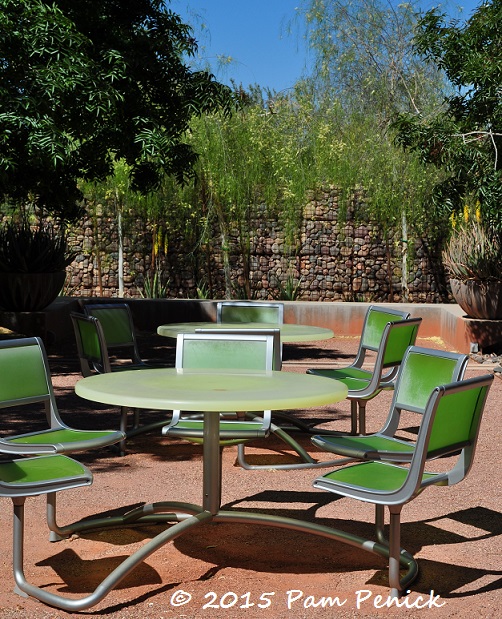
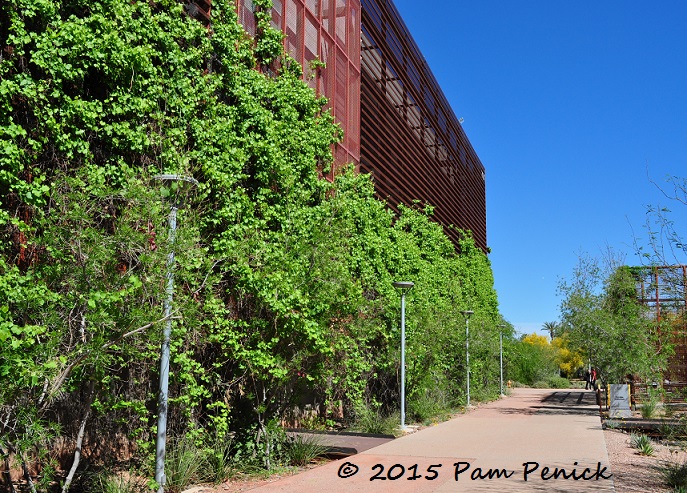
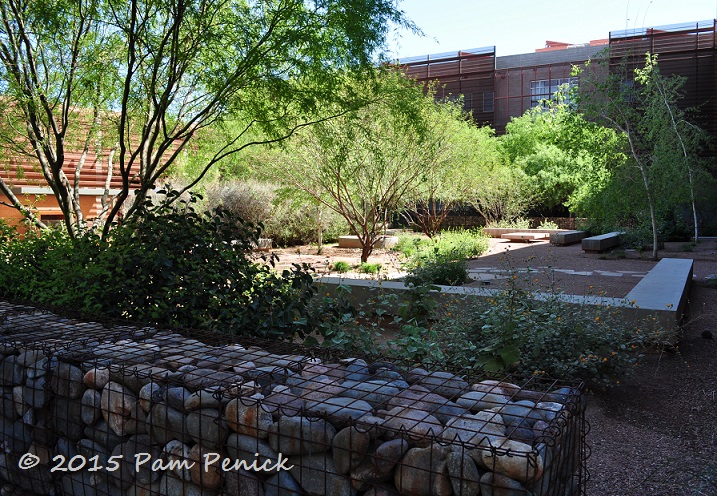
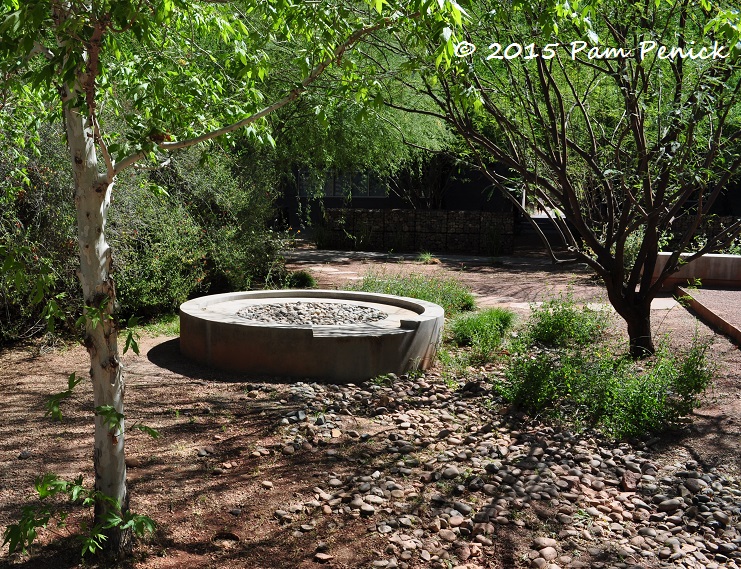
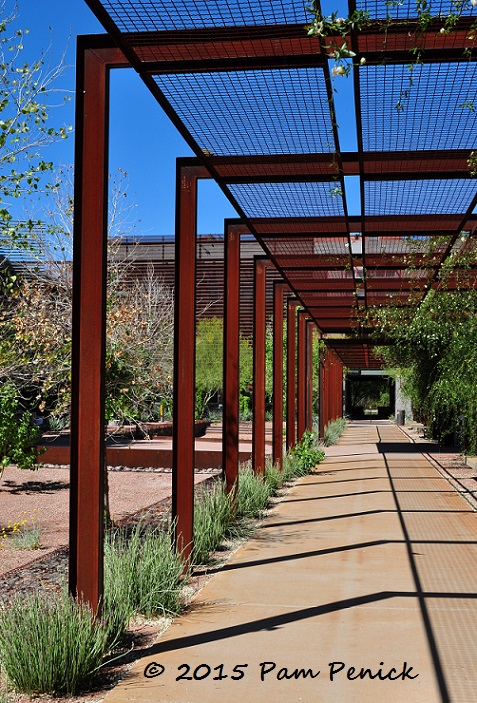
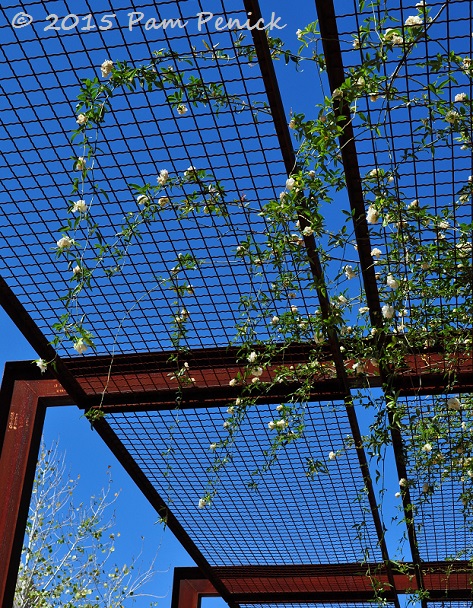
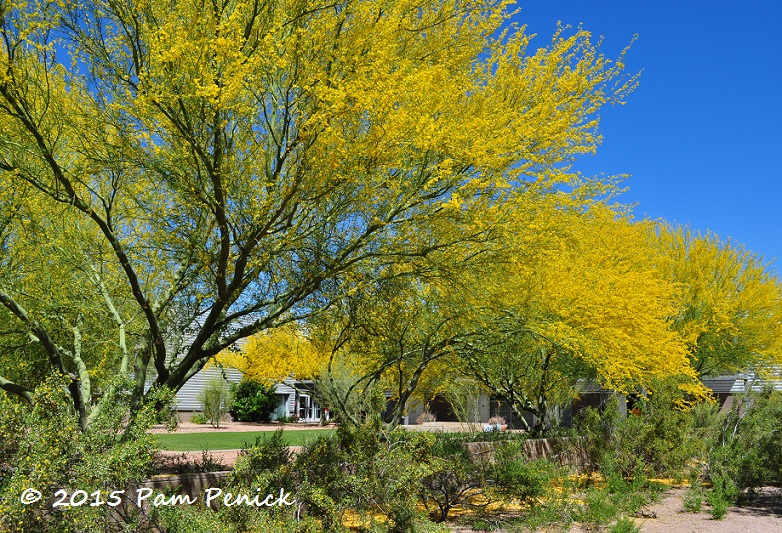
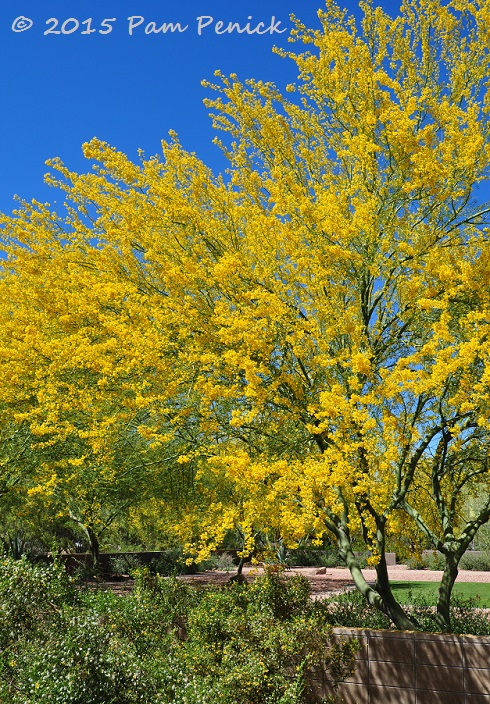
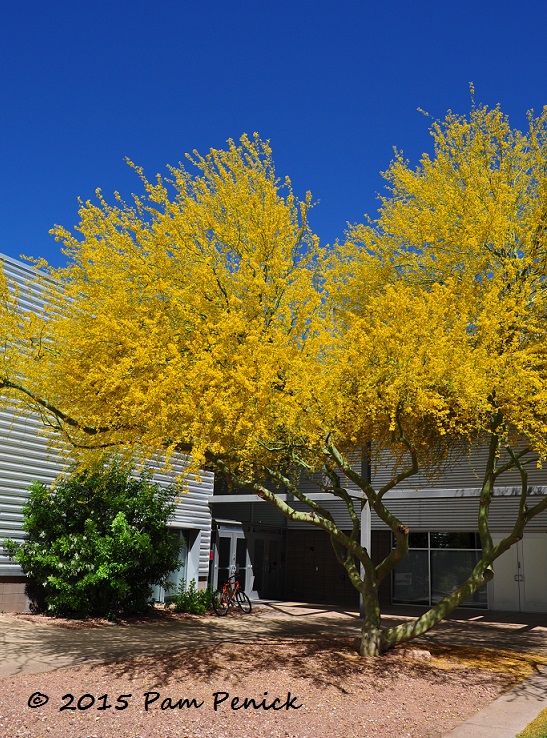
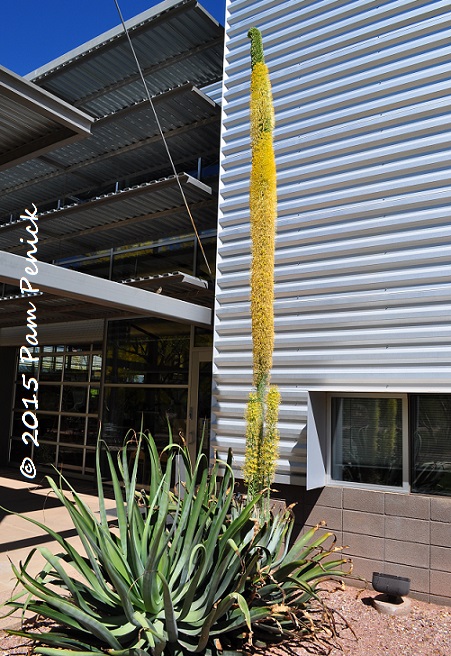
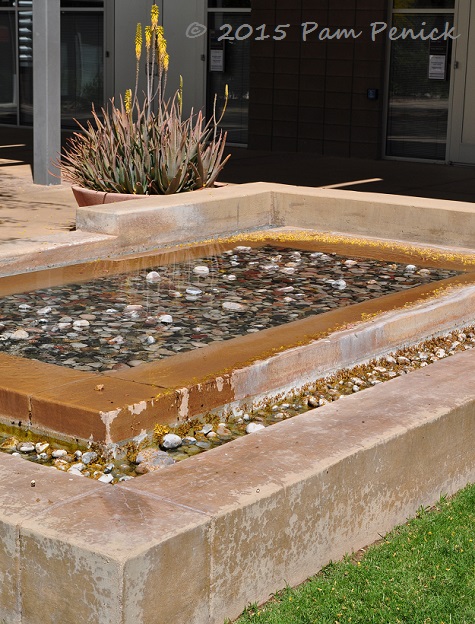
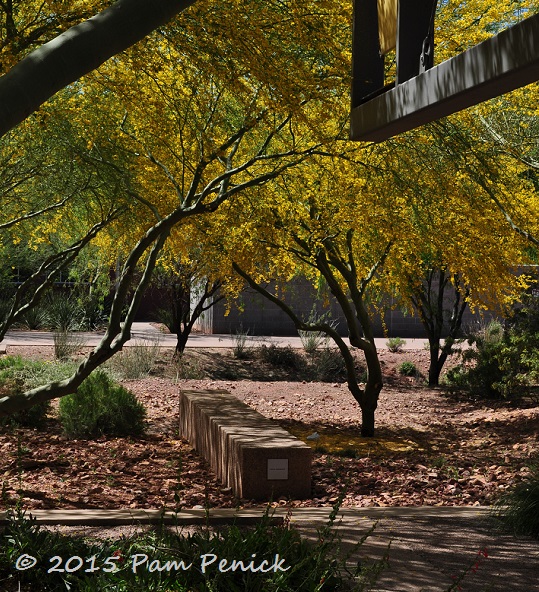
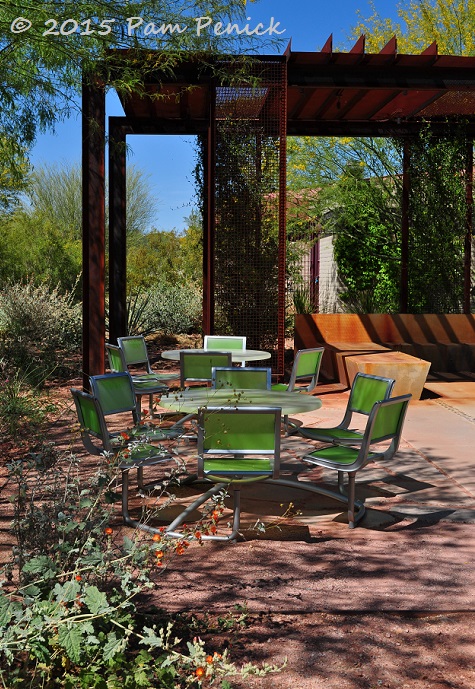
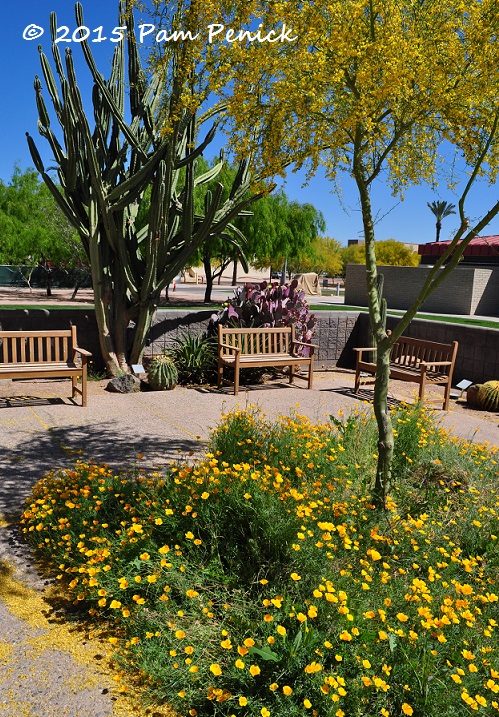
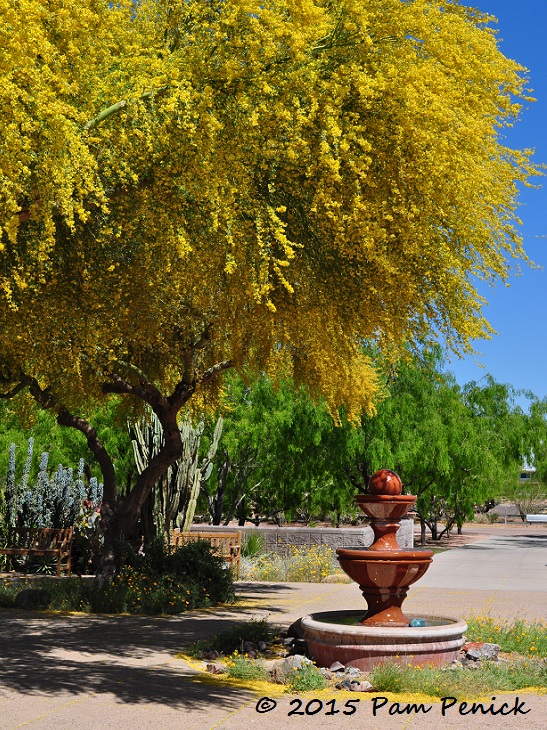
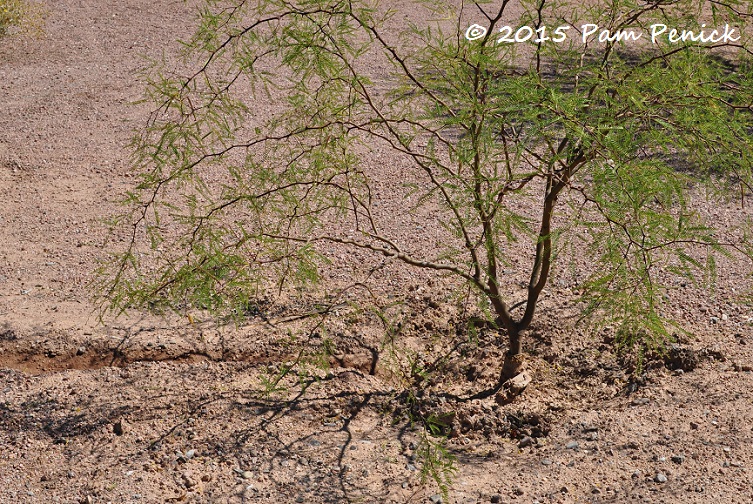
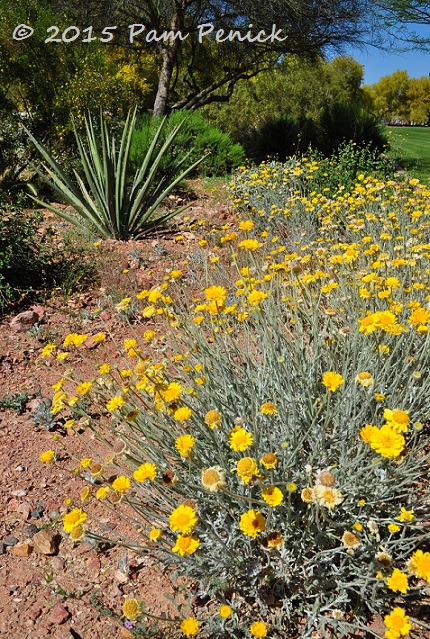
Love seeing all that blooming sunshine.
Isn’t it incredible? Looking at the pictures makes me want to book a return visit this April. —Pam
not snowbound, but I am enchanted by all those sunny yellow flowers. My wish list has Calpurnia aurea on it – dangling yellow flowers from Dec to Feb – but I haven’t tracked down a plant for sale yet.
Ooh, yeah, that’s pretty! —Pam
It’s heartening to see such beauty can exist where water habits are necessarily stingy. We may all get there in time.
It IS heartening, Ricki, to see how much beauty is to be found in even the harshest climate. And it proves you don’t have to plant what the big-box store is selling (at every location in the country) to have a beautiful garden. Look at what grows well without pampering all around you. —Pam
I agree on using smaller water features. Our stock tanks water so many bees and birds during the hot dry summers in Boise. I also use that water when I make a water change to water our plants.
I feel so strongly about this, Jeanne. By all means, we need to reduce our water usage in dry climates, but there’s room for a non-wasteful water feature in every garden. Water is life. —Pam
Those trees are gorgeous and the garden itself is inspirational, especially at the end of another parched day here in SoCal.
I’m sorry, Kris. I hope you get a good downpour soon, just in time for spring planting. —Pam
Thanks, I needed that! Yes, I’m tired of winter up here in the north. Wow, those Palo Verde trees are incredible! And the gabion walls are interesting and it sounds like very functional, too.
I bet they provide lots of critter habitat too. That’s why I’d never want a gabion bench, but a wall? Sure! —Pam
I love seeing the sun and flowers blooming somewhere at this time of the year. Those palo verde trees are magnificent.
I’m glad to offer this virtual warm-up, Commonweeder. Just to clarify, though, I took these pics last April. 🙂 —Pam
What an excellent article. Thank you for sharing this campus and how they are working with their climate. I can see why the landscape architecture plan and execution won awards!
It is so sad about Austin and the fountain ban. Austin is our state capital and the showplace for our state. The drought must be extremely severe! You could use some of that Boston melt!
We need a big pipeline to transfer all that melted snow down here, Jeanette! —Pam
What a dazzling array of yellow and blue. Such a sense of place, reflecting the dignity and exuberance simultaneously of the area’s native fauna. This campus is a primer on how to respect and focus on the advantages of a site. Of course we expect no less of Ms. Ten Eyck. Thank you for sharing your visit there!
My pleasure, Deb. Isn’t it great that Austin is now benefiting from Ten Eyck’s work too? She’s just finished a project at UT, I believe. —Pam
Love, love, LOVE. So many college campuses look like sterile business parks these days. This looks like a place where I would want to spend time, even if I wasn’t enrolled. In a climate that gets that hot, for so much of the year the only nature you’re gonna experience is during the sweaty walk from one air conditioned building to another or to your air condiditioned car. This makes the most of it.
If you ever go, Lori, April is definitely the month. The temperature was delightful, and everything was blooming. —Pam
Perfect views of those great spaces – new-to-me, wow! (trying to picture Ten Eyck personally ripping out the paving:-) Glad her office designed something far better and appropriate than rehashing an Ivy League campus “master plan”. Once I catch up on work, it’s Phx & ASU Polytechnic.
Yes to fountains in the desert, or even green ATX…15 years every day out my office, about the most delightful, high impact item I know, even if small but well-placed.
correction on Tucson = U of A, not ASU (since it’s on the way, maybe a stop there)
Thanks for the correction, David. I’ve made the change. And you know, I almost can picture Christy personally ripping up paving! —Pam
Fabulous campus and the sky was incredible. So needed this breath of spring loveliness. Thank you.
I’m glad you enjoyed it, Gail. —Pam
Very smart (on several levels) landscaping.
Yes indeed. —Pam
What a great job she did of softening that space. It’s lovely.
It was, especially in full spring bloom. —Pam
Before sunrise a couple days ago I watched a hummer fly in and take extended “leaf baths” on as many big leaves still filmed with morning dew as he could. I need to get a bird bath going again! Love Eyck’s work, that pairing of architectural plants and strong geometry.
Are there any watering restrictions in L.A. at this time, Denise? Your hummer leaf-bath sighting must have been amazing. —Pam
Thank you, thank you, thank you for a wonderful garden visit. Incredibly beautiful. And congratulations on your long-lived blog!
Thank YOU for visiting and for your kind comment, Barbara! —Pam
Tired of our cold gray winter but can’t complain too much as we’ve not been buried in snow like some places. Hopefully enough to protect the plants. What a spirit lifter this post was for me. I am not always crazy about bright yellow but those trees are spectacular. The whole design was wonderful to say nothing of its sustainability.
My visit was during peak pale verde bloom, and the whole city seemed bathed in yellow. I’ll never forget it. I’m glad you enjoyed the virtual visit, Linda. —Pam